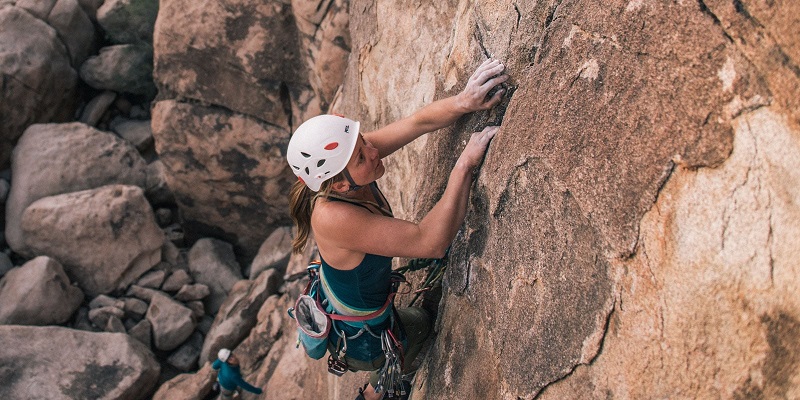A crack that runs a cliff face up presents a clear line while still increasing to follow. Figuring out how to scale a fracture could be hard, particularly if you’re new to crack scaling.
Fundamental to each of crack scaling is jamming. Jamming means extending or torqueing them to make a safe hold and integrating your hands, limbs or feet to some crack. Jamming can be painful and hard, but it is frequently the only way.
Organizing to Crack Climb
Eliminate jewelry: It is wise to remove your rings, bracelets and watches whenever you grow, but it is particularly important once you crack climb. Everything will be scratched by stones up when you jam your hand and rings could get trapped and cause damage.
Suggestion: Place your rings onto a necklace created from a sheet of two –3mm accessory cable.
Tape your palms: in spite of the very best technique, if you are doing a great deal of crack climbing, then you are likely to have scraped up. It’s possible to utilize 1.5 in. Broad tape to generate tape gloves. These helps protect your hands in a fracture and allow you jam out of the scratches. You will find this helpful as you know you want to jam if you are a newcomer.
You might choose to tape if you’re going to be climbing cracks. To try it, split the tape to 0.75 in. Strips and then wrap the strips.
Hand Jams
Jams are the form of jam and they stable. Irrespective of your hand dimensions, there is that a fracture approximately 2 in. Broad is the dimensions for hand jams.
How to Hand Jam
You want to insert your hands and then enlarge and torque your hands to lock it to earn a handshake. This can feel painful and strange at first, but with practice you will realize a handshake is among the most protected.
Hand jam technique:
- Insert your hand into the crack
- Cup your hand
- Squeeze your thumb into your palm. (For tight hand cracks, press your thumb into the side of your index finger)
The action is the thing that generates the jam and expands your hands. Your palms, the back of your hands and heel of the hands will be in touch.
For broad hand cracks: Twist your hands to fill the distance and camera it into position. Irrespective of whether your palms are thumbs-up or even thumbs-down, it works better to spin your right hand clockwise along with your hand counterclockwise.
Where to put a handshake: locate a constriction at the crack. the meaty portion of the hand’s rests on the cover of the constriction slot your wrist. This will make a jam that is secure. Squeezing your thumb and cupping your hands will raise the ability of this jam.
Keep it quiet: as soon as you’ve discovered a fantastic handshake, keep your hands from shifting around in the crack. A great deal of motion can scratch your hand up.
Foot Jams
Conveniently may also accept your toes.
Foot jam technique:
- Bend one knee and then turn it out (your pinkie toe will probably be flipped down toward the floor)
- Insert your feet into the fracture using the sole of this shoe touching the side of the fracture
- Bring back your knee in line with your body
- Smear your foot to the crack
Done there is a foot dip secure. You do not need to place your foot to the crack consider adding your feet. Be careful not to torque your foot. Your foot really can hurt.
To eliminate your foot: Reverse the procedure. Transfer out your knee unwind the foot and pull on your foot.
Foot jam hints:
- While it’s tempting to fit a foot horizontally to a hand break and measure down, this can occasionally make your foot stuck since the crack is overly narrow.
- Do not forget to check away from the crack for attributes to place your toes. You do not need to rely on the crack.
Climbing up a Crack
Straight cracks: By swinging your arms in the hand jams at a fashion move. You find that adding your hands up will place you in the position that is very ordinary and effective.
Curved cracks: To get a right-curving crack, it often works better to place your right hand at a thumbs-down position over the left hand, which can be in a thumbs-up position. Continue to lead with your right hand, shuffling together it instead of bringing one hand across the other, as you make your way up the scale. Reverse this technique to get a crack.
Attain high: Ordinarily when putting palm jams, you would like to achieve high. As you eventually become flat using a hand and grow up you will want to move up your hands.
Beyond Hand Jams
Not each crack is sized on your palms. If or not a crack matches the ends of your fist or your hands, recall that like torque, expansion and hand jams are crucial.
Finger Jams
For cracks finger presses would be the answer. You produce finger jams by adding some or all your fingers into a crack, then ideally to the next or third knuckle, and lock off them onto a constriction from the crack or from rotating your elbow to torque your palms to a jam.
Footwork: So that that your toe is upward if the crack is enough, then turn your foot and attempt to get your feet. You smear your foot relying to produce the foot grip and then could press your foot onto the crack. Don’t forget to search for retains beyond the crack; confront holds can be crucial to scaling a finger crack up.
Fist Jams
Fractures need you to make a fist turn your hands so it’s either palm up or upside down and then fit it. Pressing the border of the index finger and thumb against the edge of the finger and one side of the fracture generates the jam. Your hands are caused by clenching your fist.
At which you can slot your wrist over Much like hand jams, start looking for constrictions from the crack.
Footwork: Fist jams may be hard, so you will have to ensure to use your feet nicely. The diameter of a crack lets you fit your foot in and stand up without needing to be concerned about having your foot. You may even try torqueing it like you would to get a crack and then inserting your foot. For scaling cracks that are fist-size stiff shoes work well.
Off-Width Jams
Dreaded by climbers’ fractures are too broad for your palms but also narrow.
Growing a crack is pretty and frequently involves groveling to reach the top and grunting. Knee presses arm bars jams and hands stacking are some of the techniques you will have to employ.
While off-widths are frequently avoided by climbers, understand this: you might find you like a crack and with exercise the motions will get simpler.
Shoes for Crack Climbing
The ideal goes a long way toward creating crack climbing enjoyable and comfy.
Go low-profile: Lace-up sneakers are favored for crack climbing since they have a thinner profile than sneakers with hook-and-loop strap closures. You need be certain that your feet lay flat so that they can slide into cracks and crack climbing shoes. Crack can be made by shoes with some padding.
Shoes have a profile than sneakers, which makes them a fantastic selection for cracks that are thin.
Stiffness: Using a shoe that is too soft, you will feel each sharp edge once you jam your foot. Having you won’t have sufficient sensitivity to endure on smear or borders. Start looking. If you climb wider and cracks, shoes around the end of this spectrum will provide you help.
Climbing shoes have ankles that were low-cut some shoes have been intended to pay for the anklebones, providing protection for scaling cracks that were wider.

